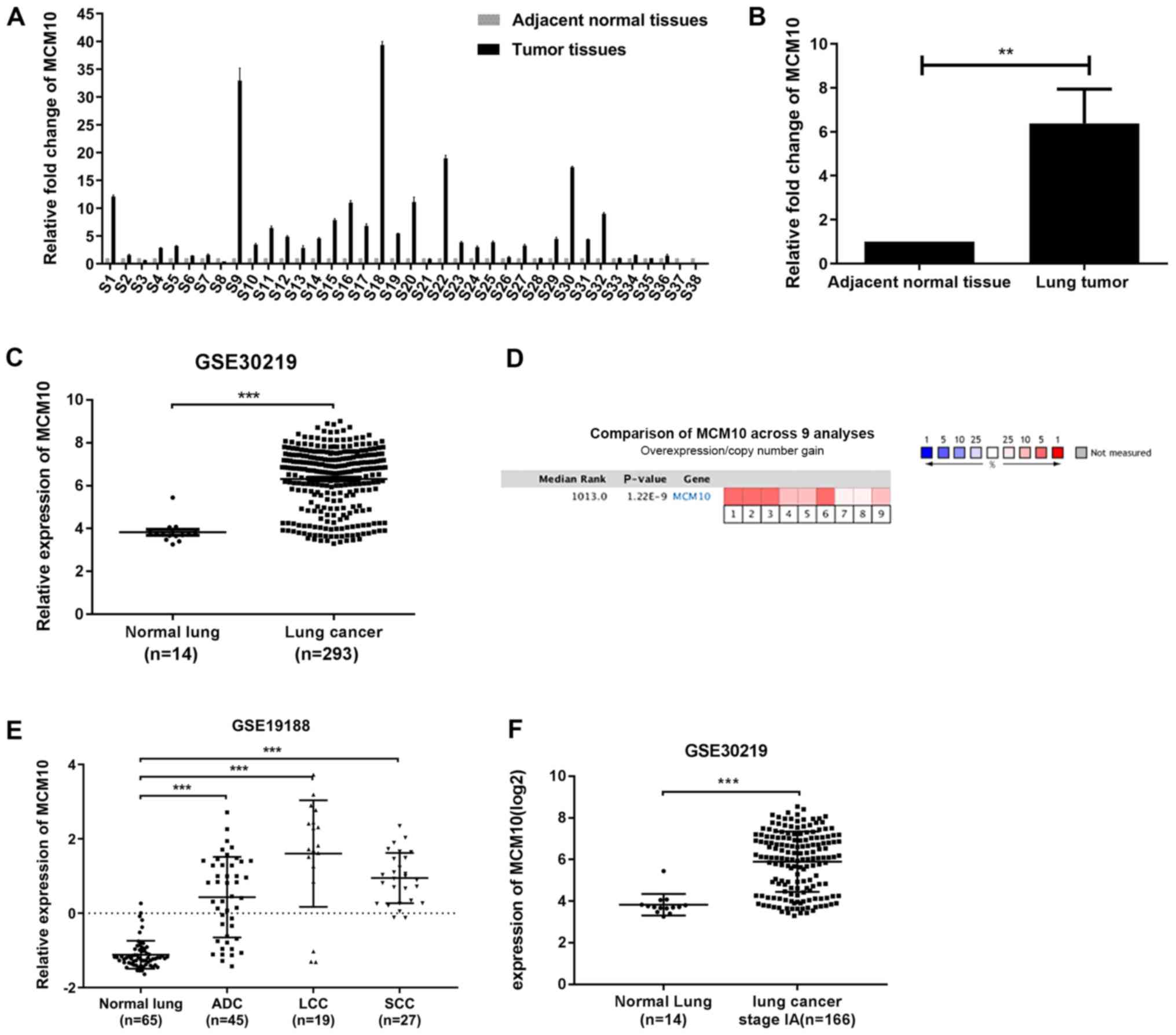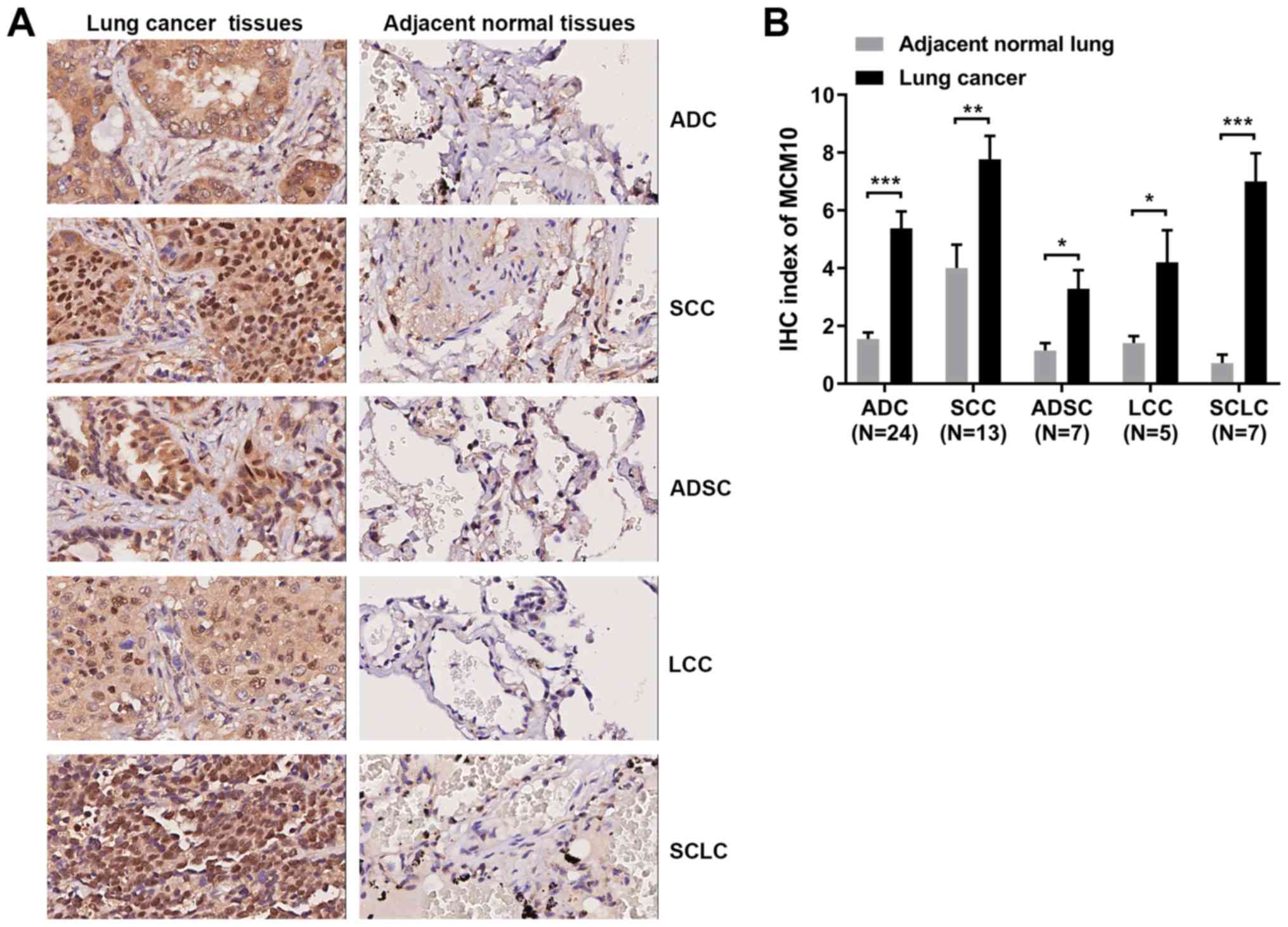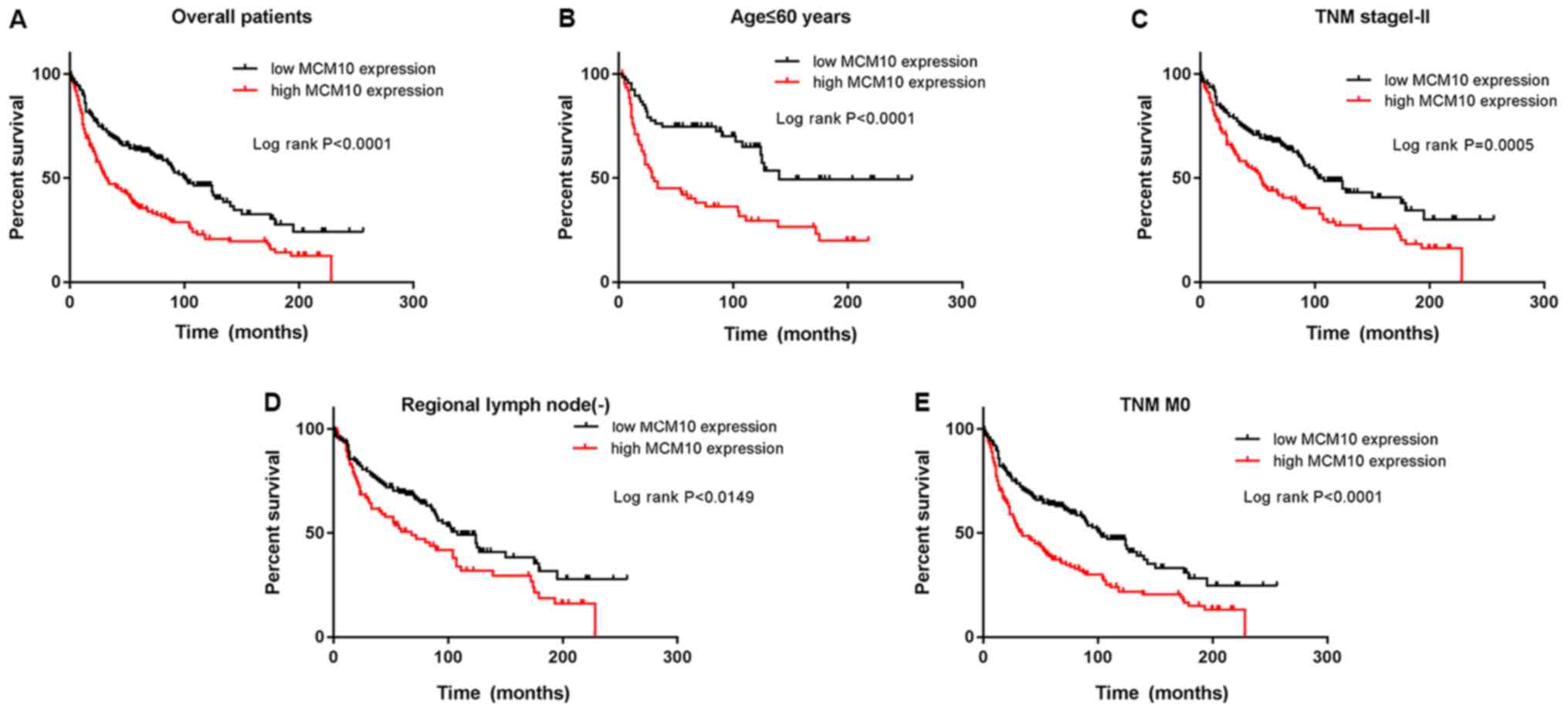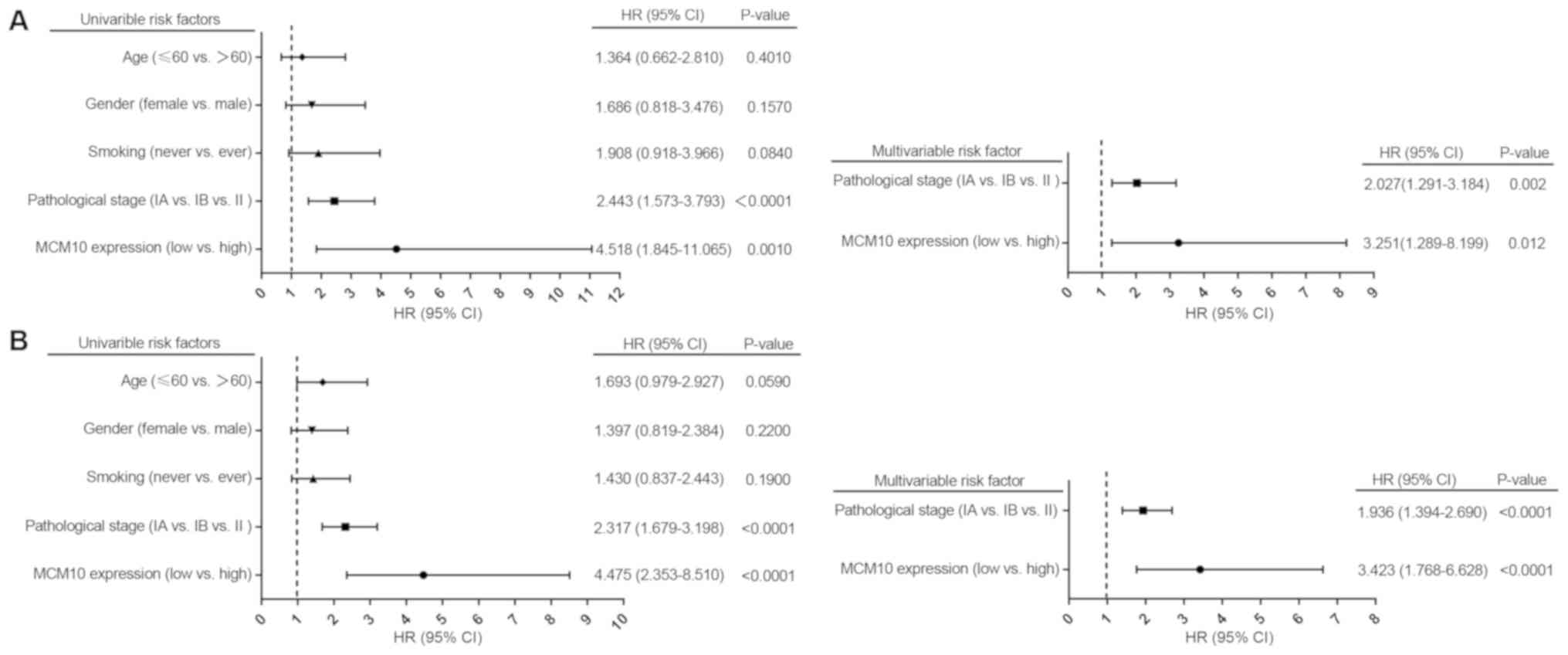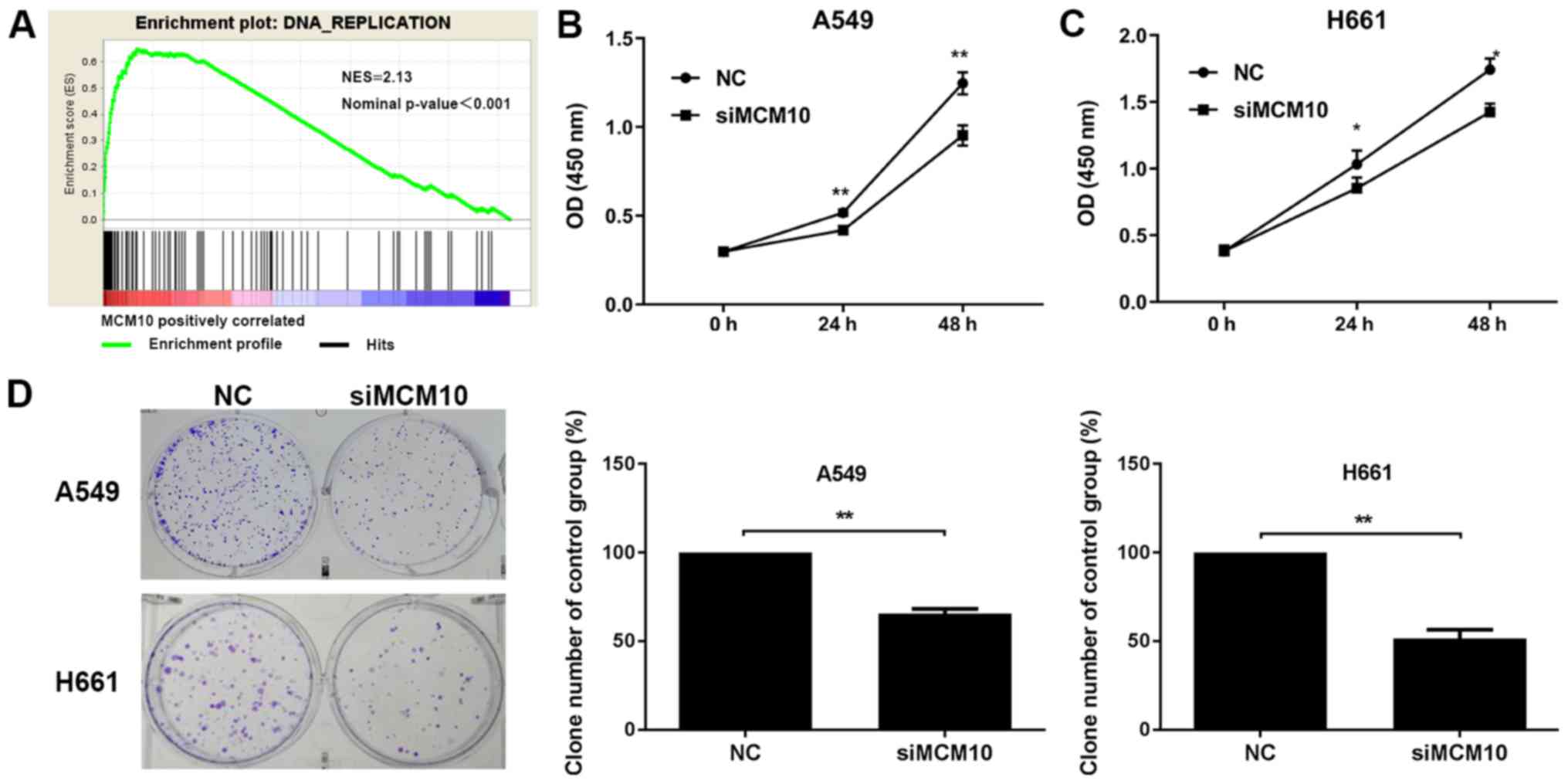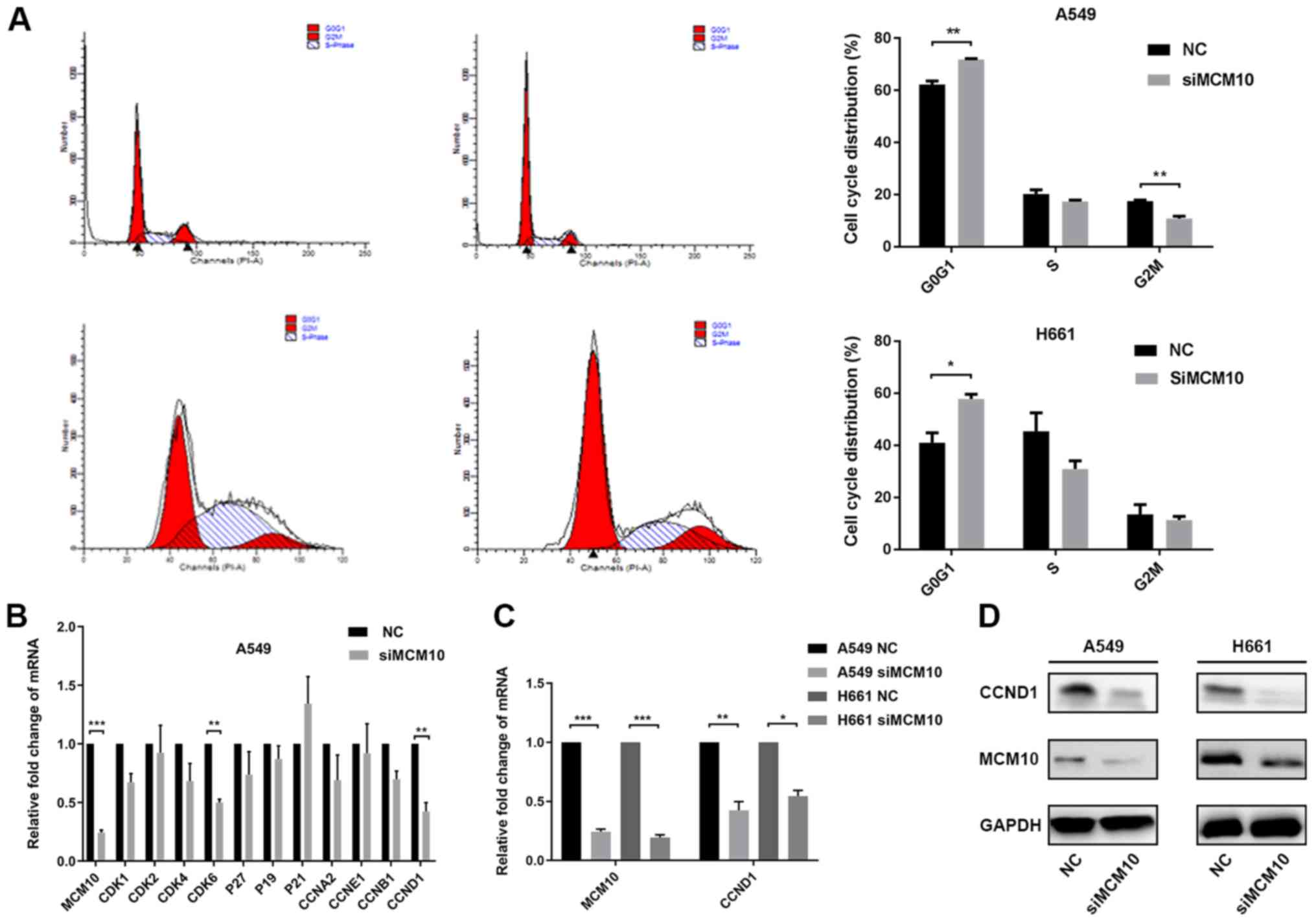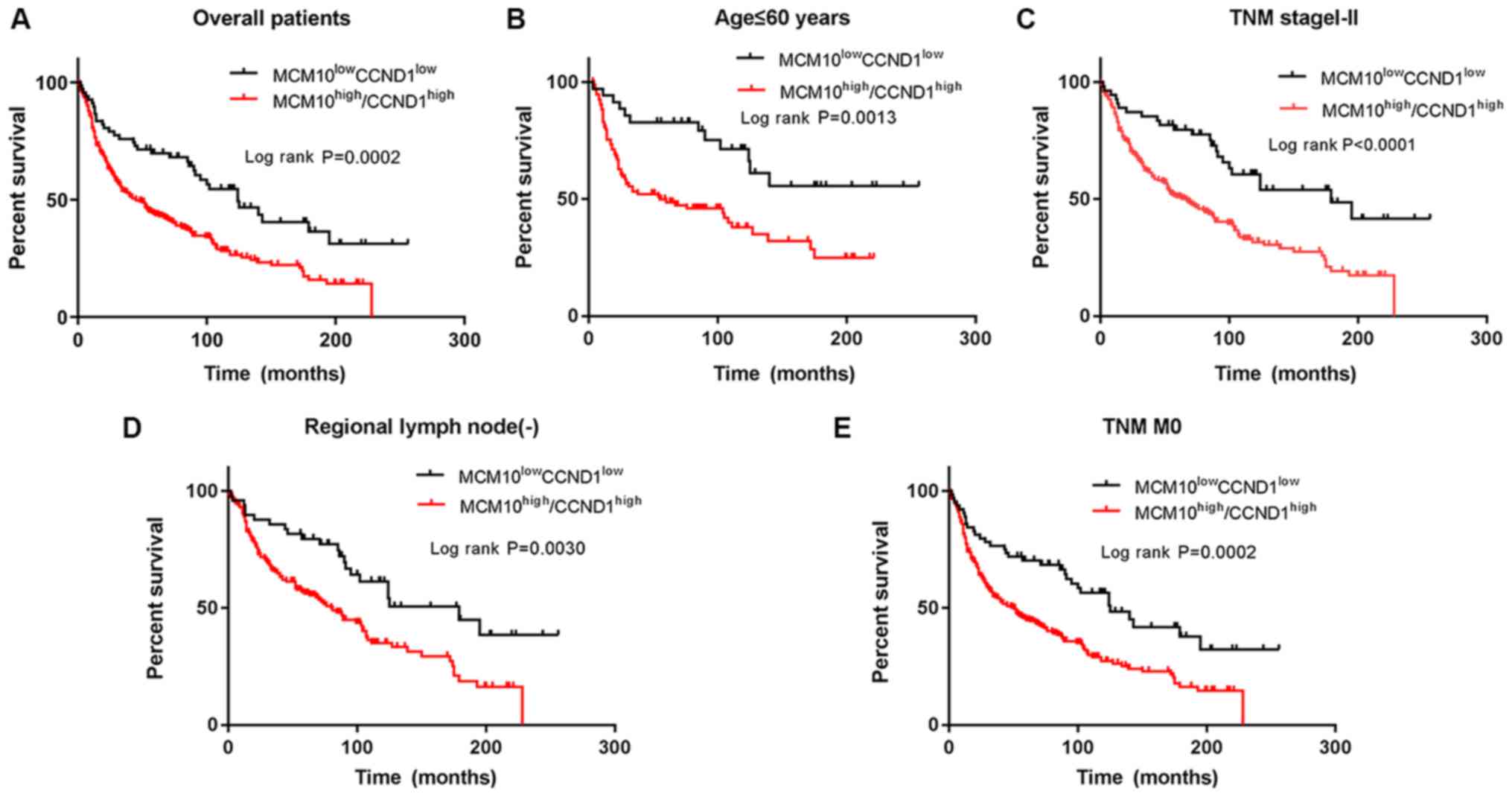Minichromosome maintenance protein 10 as a marker for proliferation and prognosis in lung cancer
- Authors:
- Published online on: October 14, 2019 https://doi.org/10.3892/ijo.2019.4899
- Pages: 1349-1360
-
Copyright: © Wang et al. This is an open access article distributed under the terms of Creative Commons Attribution License.
Abstract
Introduction
Lung cancer is the leading cause of cancer-related deaths (1). The recent statistics by the American Cancer Society showed that the mortality and morbidity due to lung cancer in 2018 was approximately 154,050 and 234,040, respectively (2). Despite the advances in surgical techniques and molecular therapy for lung cancer, the 5-year survival of patients with non-small cell lung cancer (NSCLC) is only 21% (3). Based on the Surveillance, Epidemiology, and End Results data report in 2014, the rate of lung cancer diagnosis in early stages is only 16% (3). Moreover, 40 and 60% patients with stages IB and II lung cancer, respectively, relapse despite receiving surgery and adjuvant chemotherapy (4). Identification of new biomarkers to assess the prognosis of lung cancer is crucial for effective clinical decision-making and survival improvement.
Minichromosome maintenance complex component 10 (MCM10) is a conserved component of an eukaryotic replication fork (5,6) and originally identified as an allele of DNA43 in Saccharomyces cerevisiae (7,8). Along with other DNA replication proteins, it plays a vital role in DNA replication-related processes such as promoting the initiation of DNA replication (9), activating helicase (10-12) and contributing to polymerase loading (13,14), as well as controlling replication fork stability to sustain elongation (15,16). However, the expression level of MCM10 is abnormally increased during tumorigenesis (17-19). It has been demonstrated that over-expression of MCM10 is driven by the EWS RNA binding protein 1 (EWS)/Fli-1 proto-oncogene, ETS transcription factor (FLI1)-nuclear receptor subfamily 0 group B member 1 (DAX1) interaction in Ewing's sarcoma (17). In addition, in a previous study, MCM10 was significantly elevated in medulloblastoma cell lines and tissues when compared with corresponding control groups, and knockdown of MCM10 inhibited the proliferation of medulloblastoma cells (18). Another study revealed that high MCM10 expression was observed in glioma samples and related to tumor grade (19). Furthermore, abnormally increased MCM10 expression was found to be associated with malignant clinicopathological characteristics, worse disease-specific survival and inferior metastasis-free survival in urothelial carcinoma (20).
Despite the elevated MCM10 levels found in various cancer types, its role in lung cancer pathogenesis remains elusive. Therefore, further research is required to uncover the molecular mechanism and prognostic implication of MCM10 in lung cancer. To this end, MCM10 expression levels in lung cancer versus non-tumor tissue, the correlation between MCM10 expression and clinicopathologic characteristics, and the prognostic potential of MCM10 expression in lung cancer were investigated. Furthermore, in the current study, the expression of MCM10 was knocked down by small interfering RNA to explore its biological role and molecular mechanism involved in the pathogenesis of lung cancer.
Materials and methods
Cell culture and transfection
Lung cancer cell lines A549 and H661 were obtained from the American Type Culture Collection and cultured in RPMI-1640 medium (Gibco; Thermo Fisher Scientific, Inc.) with 10% FBS (Gibco; Thermo Fisher Scientific, Inc.), 100 U/ml penicillin and 100 µg/ml of streptomycin, and maintained in 5% CO2 atmosphere at 37°C. Small interfering RNA (siRNA) sense, 5′-GCACAAACTTGATCATCCA-3′ targeting the human MCM10 (siMCM10) and negative control siRNA (NC; cat. no. NControl_05815) synthesized by Guangzhou RiboBio Co., Ltd. 100 nM siRNA and NC were transiently transfected into lung cancer cells using Lipofectamine® 3000 (Thermo Fisher Scientific, Inc.), according to the manufacturer's protocol. The cells were used for subsequent experimentation after 48-h transfection.
Clinical specimens
A total of 38 pairs of primary lung cancer and adjacent normal tissue samples were obtained from patients who underwent surgical operations at the Renmin Hospital of Wuhan University between May 2017 and November 2017 (age range, 41-75 years; 23 males and 15 females). All patients provided informed consent. Samples were immediately frozen in liquid nitrogen for MCM10 mRNA expression analysis. Human lung tissue microarrays including 56 pairs of primary lung cancer and corresponding adjacent normal lung/bronchiole tissues were purchased from Shanghai Outdo Biotech Company Co., Ltd. The tissue microarrays contained 24 adenocarcinoma (ADC), 13 squamous cell carcinoma (SCC), 7 adenosquamous carcinoma (ASC), 5 large cell lung carcinoma (LCLC) and 7 of small-cell lungs carcinoma (SCLC) samples.
Bioinformatics and statistical analysis
MCM10 transcript level in lung cancer was determined from the Oncomine database (https://www.oncomine.org). A total of 7 datasets were selected using the following filter settings: MCM10, analysis type: Cancer vs. Normal analysis; Cancer type: Lung cancer. Comparison of MCM10 across 9 analyses was performed based on the screening criteria. The details of the analyses are listed in Table I. Gene expression omnibus (GEO) database (http://www.ncbi.nlm.nih.gov/geo/) was used as a source to downloaded GSE30219 (21), GSE19188 (22) and GSE31210 (23) microarrays datasets. A total of 22 cases in GSE31210 were excluded from univariate and multivariate Cox proportional hazards regression analysis due to incomplete resection or adjuvant therapy. Tumor recurrence was classified as either early or late using 2 years as the cutoff. The expression pattern of MCM10 and the corresponding clinical data were extracted and analyzed. Kaplan-Meier (KM) Plotter (http://kmplot.com/analysis/index.php?p=service&cancer=lung) was used to determine the prognostic significance of MCM10. The following settings were used to obtain the KM survival plots: Gene symbol, MCM10; split patients by, median; survival, overall survival (OS), follow up threshold, all; histology, all/ADC/SCC; all other settings, all. The categorization of MCM10 expression (low vs. high) was based on the median expression level. Log rank P-values and hazard ratios (HRs) with 95% confidence intervals (CIs) were calculated and extracted from the KM Plotter webpage. The expression level of MCM10 in the Cancer Genome Atlas (TCGA) dataset was also analysed by UALCAN (http://ualcan.path.uab.edu). The role of MCM10 in biological pathways was investigated using gene set enrichment analysis (GSEA; version 3.0; Broad Institute, Inc.) and the GSE3141 (24) dataset with functional gene set files (GSEA file, c2.cp.v4.0.symbols.gmt) to access enriched gene sets.
Table IComparison of minichromosome maintenance complex component 10 expression across nine analyses. |
Immunohistochemistry (IHC) assay
Paraffin was removed from the microarray tissue samples by treating with xylene twice for 10 min followed by rehydration with gradient alcohol for 5 min. Sodium citrate buffer (Wuhan Servicebio Technology Co., Ltd.; 10 mM; pH 6) was used for antigen retrieval and the samples were heated at 100°C in a microwave oven. Endogenous peroxidase activity was inhibited by treating the slides with 3% hydrogen peroxide. The tissue microarray was incubated with primary antibodies for MCM10 at 4°C (1:100; cat. no. DF12162; Affinity Biosciences). After overnight incubation, the microarray slides were rinsed with PBS and incubated with horseradish peroxidase (HRP)-labeled goat anti-rabbit IgG (Wuhan Servicebio Technology Co., Ltd.; 1:200; cat. no. GB23303) at 37°C for 30 min and the reaction was visualized by using a fresh solution of 3,3′-diaminoben-zidine. The same criteria were used for evaluate the staining intensity and proportion of positive stained cells in each sample. The staining intensity was scored as 0 (no staining), 1 (pale yellow), 2 (yellow) and 3 (brown). The proportion of stained cells was defined as 0 (0-5% positive staining), 1 (6-25% positive staining), 2 (26-50% positive staining), 3 (51-75% positive staining) and 4 (>75% positive staining). The multiplication of staining intensity score and proportion of positive cells score was used as the IHC index. The IHC index ≥5 was defined as high expression of MCM10, while IHC index ≤4 was defined as MCM10 low expression.
Western blotting
After washing with PBS, total protein was extracted from transfected cells using RIPA (Beyotime Institute of Biotechnology) supplemented with a protease inhibitor cocktail PMSF (Kangchen BioTech Co., Ltd.) on ice for 30 min followed by quantification of the protein in the lysate using a BCA kit purchased from Thermo Fisher Scientific, Inc. Protein samples were separated using SDS-PAGE (10% gel) and transferred onto a polyvinylidene difluoride membrane at 200 mA for 2 h. Following an overnight incubation with an anti-MCM10 antibody (1:3,000; Abcam; cat. no. ab3733) or an anti-cyclin D1 (CCND1) antibody (1:3,000; ABclonal Biotech Co., Ltd.; cat. no. A10757) at 4°C, the membranes were incubated with a goat anti-rabbit IgG (1:10,000; ProteinTech Group, Inc., cat. no. 10285-1-AP) at 37°C for 1 h after washing with TBS with Tween-20. The protein signal was detected using an Novex™ ECL Chemiluminescent Substrate Reagent kit (Thermo Fisher Scientific, Inc.).
Reverse transcription-quantitative PCR (RT-qPCR)
Total RNA from the cell lines and tissues were isolated using the TRIzol® reagent (Takara Bio, Inc.) and quantified with NanoDrop™ 2000 (Thermo Fisher Scientific, Inc.). Using the PrimeScript RT-PCR kit (Takara Bio, Inc.), 2 µg RNA was converted to cDNA following the manufacturer's protocol. The quantification of gene expression was performed by qPCR using SYBR Premix Ex Taq™ (Takara Bio, Inc.). The Cq value of target gene was normalized according to the reference gene (β-actin) using the 2−ΔΔCq method (25). The following thermocycling conditions were used: 50°C for 30 min, 94.5°C for 15 min; 40 cycles of 96°C for 30 sec and 59.7°C for 1 min. The primer sequences used for the qPCR analysis were as follows: MCM10 forward, 5′-CCCCTACAGACGATTTCT CGG-3′ and reverse, 5′-CAGATGGGTTGAGTCGTTTCC-3′; CCND1 forward, 5′-GCTGCGAAGTGGAAACCATC-3′ and reverse, 5′-CCTCCTTCTGCACACATTTGAA-3′; β-actin forward, 5′-GAAGAGCTACGAGCTGCCTGA-3′ and reverse, 5′-CAGACAGCACTGTGTTGGCG-3′; CDK4 forward, 5′-AT GGCTACAAGCAGATATGAG-3′ and reverse, 5′-TCACTC GGGGTTGCCCTC-3′. CCNB1 forward; 5′-AATAAGGCG AAGATCAACATGGC-3′ and reverse, 5′-TTTGTTACCAAT GTCCCCAAGAG-3′; P27 forward, 5′-AGGAGATGTAAC TATCGGACCTC-3′, and reverse, 5′-GTTCCCTTCGCCAAT CACTATT-3′; p21 forward, 5′-TCCTGGAGCAGACCACCC CG-3′ and reverse, 5′-GGGGTGGGACAGGCACCTCA-3′; P19 forward, 5′-GGGTTTTCGTGGTTCACATCC-3′ and reverse, 5′-CTAGACGCTGGCTCCTCAGTA-3′; CCNA2 forward, 5′-GGATGGTAGTTTTGAGTCACCAC-3′ and reverse, 5′-CACGAGGATAGCTCTCATACTGT-3′; CCNE1 forward, 5′-GCCAGCCTTGGGACAATAATG-3′ and reverse, 5′-CTTGCACGTTGAGTTTGGGT-3′; CDK6 forward, 5′-TC TTCATTCACACCGAGTAGTGC-3′ and reverse, 5′-TGAGGT TAGAGCCATCTGGAAA-3′; CDK2 forward, 5′-CCAGGA GTTACTTCTATGCCTGA-3′ and reverse, 5′-TTCATCCAG GGGAGGTACAAC-3′; CDK1 forward, 5′-GGATGTGCTTAT GCAGGATTCC-3′ and reverse, 5′-CATGTACTGACCAGG AGGGATAG-3′.
Cell Counting Kit-8 (CCK-8) and colony formation assays
CCK-8 (Dojindo, Molecular Technologies, Inc.) and colony formation assays were used to determine the proliferation ability of lung cancer cells. For the CCK-8 assay, 3,000 cells were seeded in 96-well cell culture plates and allowed to grow overnight. The cells were then transfected with siRNA as aforementioned for 48 h. At indicated culture points (0, 24 and 48 h), 10 µl CCK-8 was added to each well and incubated for another 2 h at 37°C. The measurement of absorbance was done at a wavelength of 450 nm. For the colony formation assay, after 48 h of transfection, the cells were seeded in six-well cell culture plates at a density of 500 cells/well for 14 days. The number of colonies was counted after fixing and staining with 1% crystal violet (containing with 4% methanol) for 10 min at 37°C.
Cell cycle and apoptosis analysis
Cell cycle progression was assessed using cell cycle detection kit (KeyGEN BioTech Co., Ltd.; cat. no. KGA511) 48 h post transfection. Cells were resuspended in 70% ethanol at −20°C overnight. The cells were washed with cold PBS, subsequently treatment with 100 µl RNase for 30 min at 37°C and 400 µl PI for 30 min at 4°C before flow cytometry analysis. The DNA content was analyzed with ModFit software (version 3.2; Verity Software House). Cell apoptosis was detected by flow cytometry (BD FACSARia™ III; BD Biosciences) after staining with Annexin V-allophycocyanin and PI (BD Biosciences; cat. no. 556547) according to the manufacturer's protocol. The apoptosis rate was calculated as the sum of early and late apoptosis.
Statistical analysis
GraphPad Prism (version 5.0; GraphPad Software, Inc.) and SPSS (version 17.0; SPSS, Inc.) were used for statistical analysis. Differences between paired samples were analyzed using a paired Student's t-test. Independent groups were analyzed using an unpaired Student's t-test. Multiple groups were compared using one-way ANOVA followed by Dunnett's test. The association between the expression level of MCM10 and the clinicopathological factors was explored using the Chi-square test. Univariate and multivariate survival analyses were performed using the Cox proportional hazards regression model. Factors with prognostic significance in the univariate analysis were included in the subsequent multivariate analysis. The diagnostic value of MCM10 was evaluated by receiver operating characteristic (ROC) analysis and area under the curve (AUC). Data are presented as the mean ± SEM of three independent experiments, each performed in triplicate. P<0.05 was considered to indicate a statistically significant difference.
Results
Upregulation of MCM10 in lung cancer
Quantification of the MCM10 expression level in 38 paired lung cancer and adjacent normal tissue samples was performed (Fig. 1A). The results revealed a significantly elevated MCM10 mRNA expression level in lung cancer tissues compared with the normal tissues (Fig. 1B). Subsequently, the GSE30219 dataset was selected to further assess the differences in MCM10 expression between cancerous and normal lung tissue samples. The results were consistent with the data derived from patients recruited in the present study (Fig. 1C). The expression analysis of MCM10 in different histological subtypes was carried out using the Oncomine database and GSE19188 dataset. The Oncomine results demonstrated the overexpression of MCM10 in lung tissues across 9 analyses. The median rank of MCM10 was 1,013 among upregulated genes by cluster analysis in lung cancer (Fig. 1D and Table I). MCM10 expression was significantly higher in ADC, SCC and SCLC compared with normal lung tissues (Fig. 1E). The expression level of MCM10 was also significantly upregulated in lung cancer compared with normal samples included in TCGA database (Fig. S1). Moreover, stage IA of lung cancer exhibited a higher MCM10 expression than normal lung tissue (Fig. 1F). In order to evaluate the diagnostic value of MCM10, the GSE30219 dataset was used to perform ROC analysis. The result showed that MCM10 discriminated a lung cancer patient from a healthy individual with a ROC area under the curve of 0.927 (95% CI, 0.0.887-0.966) (Fig. S2).
Furthermore, upon investigation of the MCM10 expression level in 56 pairs of cancer and adjacent normal tissue samples from the lung tissue microarray by IHC, the positive staining of MCM10 was mainly found in the nucleus and partly in the cytoplasm of the lung cancer cells (Fig. 2A). Among the 56 cases of lung cancer, 33 (58.9%) lung cancer tissues showed high expression (IHC index ≥5) of MCM10, whereas the adjacent normal lung/bronchiole tissues had a low level or negative MCM10 expression (IHC index ≤4). In addition, MCM10 expression was upregulated in all histopathological types of lung cancer compared with the adjacent normal tissue (Fig. 2B). These findings suggested an oncogenic potential of MCM10 in the pathogenesis of lung cancer.
Increased expression of MCM10 is associated with more aggressive clinicopathological features of lung cancer
GSE31210 dataset was used to investigate whether MCM10 expression was associated with clinical pathological features of lung cancer. An increased expression level of MCM10 was significantly associated with the pathological properties of lung cancer, such as pathological stage, early recurrence and late recurrence, without having a significant association with age and gender (Table II).
Table IIAssociation between MCM10 expression and clinicopathological features of 204 stage I-II primary lung adenocarci-noma patients from the GSE31210 dataset. |
Higher MCM10 expression predicts poor survival in lung cancer patients
The KM plotter database was used to analyze the prognostic potential of MCM10 in lung cancer. The categorization of MCM10 expression (low vs. high) was based on the median expression level. High MCM10 expression level contributed to the shorter OS time of patients with lung cancer [n=1,926; HR, 1.82; 95% CI, 1.6-2.07, log rank P<1×10−16; Fig. 3A]. The current study also analyzed the association between MCM10 expression and the prognosis of patients with ADC and SCC. The results revealed that increased MCM10 expression had a negative effect on the survival of ADC patients [n=720; HR 2.25; 95% CI, 1.76-2.87, log rank P=2.6×10−11; Fig. 3B]. However, no difference was observed among SCC patients [n=524, HR 1.05; 95% CI, 0.83-1.33), log rank P=0.69, Fig. 3C]. In addition, analysis of the GSE30219 dataset (n=293), revealed a shorter OS time for patient with high MCM10 expression compared with patients with low MCM10 expression (Fig. 4A). The prognostic value of MCM10 was also evaluated with respect to clinicopathological features of lung cancer patients. A positive association between MCM10 expression and decreased survival probability was observed in lung cancer patients with less malignant characteristics such as age ≤60 years, early T-stage, negative lymph node infiltration and no distant metastasis. The KM analysis indicated a longer median OS for patients with reduced MCM10 expression in the stratified subgroups (all P≤0.0149; Fig. 4B-E).
MCM10 expression is an independent predictor for OS and recurrence-free survival of lung cancer patients
In order to investigate the role of MCM10 expression as an independent predictor of a shorter OS and recurrence-free survival in early stages of lung cancer, the GSE31210 dataset was used for prognosis analysis. This dataset contained 204 cases of I-II stage lung cancer; however, 22 cases were excluded due to incomplete resection or adjuvant therapy. Univariate analysis showed that high MCM10 expression (P=0.001) and pathological stage II (P<0.0001) were associated with poor OS in lung cancer patients (Fig. 5A). The incorporation of the significant characteristics into the multivariate analysis revealed that pathological stage (HR, 2.027; 95% CI, 1.291-3.184; P=0.002) and MCM10 expression (HR, 3.251; 95% CI, 1.289-8.199; P=0.012) were independent prognostic factors of OS. Furthermore, the current results also indicated that MCM10 expression was an independent prognostic factor for recurrence-free survival both in univariate analysis (HR, 4.475; 95% CI, 2.353-8.510; P<0.0001) and multivariate analysis (HR, 3.423; 95% CI, 1.768-6.628; P<0.0001; Fig. 5B).
Inhibition of lung cancer cell proliferation by the knockdown of MCM10
GSEA was performed using the GSE3141 dataset to understand the cellular processes in the pathogenesis of lung cancer mediated by increased expression of MCM10. The samples were divided into two groups (high vs. low) using the median expression level of MCM10, and the top 20 related biological processes that satisfied P<0.05 and false discovery rate <0.25 are shown in Table III. The results suggested that the significant gene set regulated by MCM10 was mainly associated with cell cycle progression and proliferation (Fig. 6A and Table III). To confirm the GSEA analysis of MCM10, MCM10 expression was transiently knocked down in A549 and H661 cells followed by the assessment of the effect of MCM10 expression on cell proliferation using the CCK-8 assay. The results showed that the downregulation of MCM10 significantly suppressed cell proliferation (Fig. 6B and C). Consistent with the findings of the CCK-8 assay, colony formation assay also showed that lung cancer cell growth was significantly inhibited when MCM10 was knocked down (Fig. 6D).
Table IIIGSEA of the biological process associated with minichromosome maintenance complex component 10 enrichment in lung cancer. |
Downregulation of MCM10 induces G1 arrest by suppressing cyclin D1 expression in vitro
Several previous studies demonstrated the function of MCM10 in DNA replication (9,12,26); however, the effect of MCM10 on cell cycle regulation in lung cancer remains to be elucidated. Flow cytometry analysis was used to determine the effect of MCM10 knockdown on lung cancer cell cycle progression. As shown in Fig. 7A, the depletion of MCM10 significantly increased and decreased the proportion of G0/G1 and G2/M phase cells, respectively compared with the NC group in A549 cells, while knockdown MCM10 only caused G0/G1 arrest in H661 cells. An apoptosis assay was performed after 48 h of transfection; however, no significant differences were observed between the two groups (Fig. S3). To explore the mechanism of proliferation inhibition induced by MCM10 knockdown, RT-qPCR was performed to screen a spectrum of genes related to cell cycle regulation between NC and MCM10 knockdown groups. CCND1, a gene responsible for G1/S transition, was decreased to the greatest extent at the mRNA level following siMCM10 transfection (Fig. 7B and C). To confirm the effect of MCM10 on CCND1 expression at the protein level, proteins were extracted from A549 and H661 cells transfected with siMCM10 or NC. Western blotting results revealed that CCND1 was expressed at a low level in siMCM10 cells compared with the NC group (Fig. 7D).
MCM10 and CCND1 can serve as prognostic indicators of lung cancer
The potential value of CCND1 expression in predicting the survival of patients with different pathological subtypes of lung cancer was determined in the current study (Fig. S4). The results showed that high CCND1 expression only predicted a worse outcome in patients with stage I-II and negative regional lymph node infiltration compared with low CCND1 expression. Due to the aforementioned association between MCM10 and CCND1, the current study explored the combination of MCM10 and CCND1 in the prognosis prediction of patients with lung cancer. Patients were divided into an MCM10 and CCND1 low expression group and an MCM10 and CCND1 high expression group to obtain KM plots based on the GSE30219 dataset. Combination of low MCM10 and CCND1 expression was associated with a longer median OS (Fig. 8A). In addition, low MCM10 and CCND1 expression was associated with better outcomes compared with high MCM10 and CCND1 expression in patients with less aggressive characteristics such as age ≤60 years, early T-phase, negative lymph node infiltration and no distant metastasis (Fig. 8B-E), demonstrating that the combination of MCM10 and CCND1 expression may be a prognostic indicator for early-stage lung cancer patients.
Discussion
Aberrant DNA replication is a hallmark of cancer (27). Certain molecules associated with DNA replication are abnormally highly expressed in proliferating cells, especially in a variety of tumor cells (28-31). In the current study, existing clinical samples were analyzed to confirm the increased expression of MCM10 in lung cancer. It was also revealed that MCM10 overexpression was associated with more aggressive clinicopathological characteristics of lung cancer. Further analysis revealed that high expression of MCM10 predicted worse OS of patients with stage I cancer with no regional lymph node infiltration or distant metastasis suggesting that MCM10 combined with traditional TNM classification may provide more precise criteria for prognostic judgment. In addition, overexpression of MCMs in early stages of cell cycle has been documented by a number of studies, and may be ideal tumor marker for the early stage of proliferation (32-34). The current study, to the best of our knowledge, is the first to report an increased level of MCM10 expression in the IA stage of lung cancer demonstrating a possible application of MCM10 as a biomarker in the screening for early stages of lung cancer.
The precise role of MCM10 upregulation in lung cancer is not fully elucidated. Previous studies demonstrated an increased expression of MCM10 during the G1/S transition and a decreased expression level of MCM10 in the G2/M phase of the cell cycle (35-37). MCM10 gene silencing in HeLa cells led to inhibition of DNA synthesis thereby indicating that depletion of MCM10 expression may induce replication process aberrations (38,39). The current study suggested that knockdown of MCM10 resulted in cell growth inhibition and G0/G1 arrest.
To elucidate the mechanisms underlying MCM10-mediated cell proliferation, several studies have found upstream and downstream factors that could activate MCM10 (40-43). The E2F/retinoblastoma tumor suppressor protein pathway, which serves an important role in cell cycle and proliferation control, induced the expression of MCM10 in HCT116 cells (40). MicroRNAs (miRs) such as miR-146-5p have been found to regulate the expression level of MCM10 (41), and depletion of sirtuin 1 by siRNA resulted in increased levels of MCM10 and chromatin binding activity (42). Furthermore, in neuroblastoma, a strong positive correlation was observed between MCM10 and N-MYC which caused the upregulation of MCM10 by binding to its promoter (43). Similarly, a previous study investigated the regulation of MCM10 by in Ewing's sarcoma by EWS/friend leukemia integration 1 transcription factor and nuclear receptor subfamily 0 group B member 1 (17,43). The current study revealed that the expression of CCND1 was significantly inhibited in lung cancer cell lines after MCM10 downregulation causing G1 arrest of cell cycle, indicating that CCND1 may be a downstream target of MCM10. CCND1 is a cell cycle-related gene involved in tumorigenesis (44). The combination of MCM0 and CCND1 in the prognosis prediction of patients with lung cancer was therefore further predicted., the difference between low expression of MCM10 and CCND1 and high expression of MCM10 and CCND1 was significant. The result suggested that the combination of MCM0 and CCND1 may be a prognostic indicator for relatively early-stage lung cancer patients.
In conclusion, the role of MCM10 was explored by validating its oncogenic and prognostic potential in lung cancer. High MCM10 was associated with poor prognosis in lung cancer patient. Moreover, MCM10 was found to promote lung cancer cell proliferation via upregulating CCND1. The current findings suggested the potential application of MCM10 as a biomarker for the prognosis of lung cancer.
Supplementary Data
Acknowledgments
Not applicable.
Funding
This study was supported by the National Natural Science Foundation of China (NNSFC; grant nos. 81770180 and 81801954).
Availability of data and materials
The GEO datasets are available on National Center for Biotechnology Information (National Institutes of Health; http://www.ncbi.nlm.nih.gov/geo/). The online database Kaplan Meier Plotter can be accessed on http://kmplot.com/analysis/index.php?p=service&cancer=lung. The Oncomine data are available on https://www.oncomine.org. The expression level of MCM10 in the Cancer Genome Atlas dataset was determined using UALCAN (http://ualcan.path.uab.edu). The datasets used and/or analyzed during the current study are available from the corresponding author on reasonable request.
Authors' contributions
MW, SX and QZ conceived and designed the study. MW, SX and WY conducted the experiments. TX and JH were involved in statistical analysis. QY collected clinical samples and interpreted the experimental results. MJ and HS wrote and revised the manuscript. All authors have read and approved the final manuscript.
Ethics approval and consent to participate
The present study was approved by the Ethics Committee of Renmin Hospital of Wuhan University (Wuhan, China). Written informed consent was obtained from all patients.
Patient consent for publication
Written informed consent was obtained from all examined patients for the publication of their data.
Competing interests
The authors declare that they have no competing interests.
References
|
McIntyre A and Ganti AK: Lung cancer-A global perspective. J Surg Oncol. 115:550–554. 2017. View Article : Google Scholar : PubMed/NCBI | |
|
Siegel RL, Miller KD and Jemal A: Cancer statistics, 2018. CA Cancer J Clin. 68:7–30. 2018. View Article : Google Scholar : PubMed/NCBI | |
|
Miller KD, Siegel RL, Lin CC, Mariotto AB, Kramer JL, Rowland JH, Stein KD, Alteri R and Jemal A: Cancer treatment and survivorship statistics, 2016. CA Cancer J Clin. 66:271–289. 2016. View Article : Google Scholar : PubMed/NCBI | |
|
Tanaka F and Yoneda K: Adjuvant therapy following surgery in non-small cell lung cancer (NSCLC). Surg Today. 46:25–37. 2016. View Article : Google Scholar | |
|
Du W, Stauffer ME and Eichman BF: Structural biology of replication initiation factor Mcm10. Subcell Biochem. 62:197–216. 2012. View Article : Google Scholar : PubMed/NCBI | |
|
Thu YM and Bielinsky AK: Enigmatic roles of Mcm10 in DNA replication. Trends Biochem Sci. 38:184–194. 2013. View Article : Google Scholar : PubMed/NCBI | |
|
Dumas LB, Lussky JP, McFarland EJ and Shampay J: New temperature-sensitive mutants of Saccharomyces cerevisiae affecting DNA replication. Mol Gen Genet. 187:42–46. 1982. View Article : Google Scholar : PubMed/NCBI | |
|
Solomon NA, Wright MB, Chang S, Buckley AM, Dumas LB and Gaber RF: Genetic and molecular analysis of DNA43 and DNA52: Two new cell-cycle genes in Saccharomyces cerevisiae. Yeast. 8:273–289. 1992. View Article : Google Scholar : PubMed/NCBI | |
|
Merchant AM, Kawasaki Y, Chen Y, Lei M and Tye BK: A lesion in the DNA replication initiation factor Mcm10 induces pausing of elongation forks through chromosomal replication origins in Saccharomyces cerevisiae. Mol Cell Biol. 17:3261–3271. 1997. View Article : Google Scholar : PubMed/NCBI | |
|
Wohlschlegel JA, Dhar SK, Prokhorova TA, Dutta A and Walter JC: Xenopus Mcm10 binds to origins of DNA replication after Mcm2-7 and stimulates origin binding of Cdc45. Mol Cell. 9:233–240. 2002. View Article : Google Scholar : PubMed/NCBI | |
|
Jares P and Blow JJ: Xenopus cdc7 function is dependent on licensing but not on XORC, XCdc6, or CDK activity and is required for XCdc45 loading. Genes Dev. 14:1528–1540. 2000.PubMed/NCBI | |
|
Bochman ML and Schwacha A: The Mcm complex: Unwinding the mechanism of a replicative helicase. Microbiol Mol Biol Rev. 73:652–683. 2009. View Article : Google Scholar : PubMed/NCBI | |
|
Gambus A, van Deursen F, Polychronopoulos D, Foltman M, Jones RC, Edmondson RD, Calzada A and Labib K: A key role for Ctf4 in coupling the MCM2-7 helicase to DNA polymerase alpha within the eukaryotic replisome. EMBO J. 28:2992–3004. 2009. View Article : Google Scholar : PubMed/NCBI | |
|
Zhu W, Ukomadu C, Jha S, Senga T, Dhar SK, Wohlschlegel JA, Nutt LK, Kornbluth S and Dutta A: Mcm10 and And-1/CTF4 recruit DNA polymerase alpha to chromatin for initiation of DNA replication. Genes Dev. 21:2288–2299. 2007. View Article : Google Scholar : PubMed/NCBI | |
|
Thu YM and Bielinsky AK: MCM10: One tool for all-Integrity, maintenance and damage control. Semin Cell Dev Biol. 30:121–130. 2014. View Article : Google Scholar : PubMed/NCBI | |
|
Paulsen RD, Soni DV, Wollman R, Hahn AT, Yee MC, Guan A, Hesley JA, Miller SC, Cromwell EF, Solow-Cordero DE, et al: A genome-wide siRNA screen reveals diverse cellular processes and pathways that mediate genome stability. Mol Cell. 35:228–239. 2009. View Article : Google Scholar : PubMed/NCBI | |
|
García-Aragoncillo E, Carrillo J, Lalli E, Agra N, Gómez-López G, Pestaña A and Alonso J: DAX1, a direct target of EWS/FLI1 oncoprotein, is a principal regulator of cell-cycle progression in Ewing's tumor cells. Oncogene. 27:6034–6043. 2008. View Article : Google Scholar : PubMed/NCBI | |
|
Senfter D, Erkan EP, Özer E, Jungwirth G, Madlener S, Kool M, Ströbel T, Saydam N and Saydam O: Overexpression of minichromosome maintenance protein 10 in medulloblastoma and its clinical implications. Pediatr Blood Cancer. 64:642017. View Article : Google Scholar | |
|
Hua C, Zhao G, Li Y and Bie L: Minichromosome Maintenance (MCM) Family as potential diagnostic and prognostic tumor markers for human gliomas. BMC Cancer. 14:5262014. View Article : Google Scholar : PubMed/NCBI | |
|
Li WM, Huang CN, Ke HL, Li CC, Wei YC, Yeh HC, Chang LL, Huang CH, Liang PI, Yeh BW, et al: MCM10 over-expression implicates adverse prognosis in urothelial carcinoma. Oncotarget. 7:77777–77792. 2016.PubMed/NCBI | |
|
Rousseaux S, Debernardi A, Jacquiau B, Vitte AL, Vesin A, Nagy-Mignotte H, Moro-Sibilot D, Brichon PY, Lantuejoul S, Hainaut P, et al: Ectopic activation of germline and placental genes identifies aggressive metastasis-prone lung cancers. Sci Transl Med. 5:186ra662013. View Article : Google Scholar : PubMed/NCBI | |
|
Hou J, Aerts J, den Hamer B, van Ijcken W, den Bakker M, Riegman P, van der Leest C, van der Spek P, Foekens JA, Hoogsteden HC, et al: Gene expression-based classification of non-small cell lung carcinomas and survival prediction. PLoS One. 5:e103122010. View Article : Google Scholar : PubMed/NCBI | |
|
Okayama H, Kohno T, Ishii Y, Shimada Y, Shiraishi K, Iwakawa R, Furuta K, Tsuta K, Shibata T, Yamamoto S, et al: Identification of genes upregulated in ALK-positive and EGFR/KRAS/ALK-negative lung adenocarcinomas. Cancer Res. 72:100–111. 2012. View Article : Google Scholar | |
|
Bild AH, Yao G, Chang JT, Wang Q, Potti A, Chasse D, Joshi MB, Harpole D, Lancaster JM, Berchuck A, et al: Oncogenic pathway signatures in human cancers as a guide to targeted therapies. Nature. 439:353–357. 2006. View Article : Google Scholar | |
|
Livak KJ and Schmittgen TD: Analysis of relative gene expression data using real-time quantitative PCR and the 2-ΔΔCT method. Methods. 25:402–408. 2001. View Article : Google Scholar | |
|
Dutta A and Bell SP: Initiation of DNA replication in eukaryotic cells. Annu Rev Cell Dev Biol. 13:293–332. 1997. View Article : Google Scholar : PubMed/NCBI | |
|
Hanahan D and Weinberg RA: Hallmarks of cancer: The next generation. Cell. 144:646–674. 2011. View Article : Google Scholar : PubMed/NCBI | |
|
Gonzalez MA, Tachibana KE, Laskey RA and Coleman N: Control of DNA replication and its potential clinical exploitation. Nat Rev Cancer. 5:135–141. 2005. View Article : Google Scholar : PubMed/NCBI | |
|
Schrader C, Janssen D, Klapper W, Siebmann JU, Meusers P, Brittinger G, Kneba M, Tiemann M and Parwaresch R: Minichromosome maintenance protein 6, a proliferation marker superior to Ki-67 and independent predictor of survival in patients with mantle cell lymphoma. Br J Cancer. 93:939–945. 2005. View Article : Google Scholar : PubMed/NCBI | |
|
Murphy N, Ring M, Heffron CCBB, King B, Killalea AG, Hughes C, Martin CM, McGuinness E, Sheils O and O'Leary JJ: p16INK4A, CDC6, and MCM5: Predictive biomarkers in cervical preinvasive neoplasia and cervical cancer. J Clin Pathol. 58:525–534. 2005. View Article : Google Scholar : PubMed/NCBI | |
|
Korkolopoulou P, Givalos N, Saetta A, Goudopoulou A, Gakiopoulou H, Thymara I, Thomas-Tsagli E and Patsouris E: Minichromosome maintenance proteins 2 and 5 expression in muscle-invasive urothelial cancer: A multivariate survival study including proliferation markers and cell cycle regulators. Hum Pathol. 36:899–907. 2005. View Article : Google Scholar : PubMed/NCBI | |
|
Jankowska-Konsur A, Kobierzycki C, Reich A, Grzegrzolka J, Maj J and Dziegiel P: Expression of MCM-3 and MCM-7 in Primary Cutaneous T-cell Lymphomas. Anticancer Res. 35:6017–6026. 2015.PubMed/NCBI | |
|
Zakaria SH, Farag HA and Khater DS: Immunohistochemical Expression of MCM-2 in Oral Epithelial Dysplasias. Appl Immunohistochem Mol Morphol. 26:509–513. 2018. View Article : Google Scholar | |
|
Liu YZ, Wang BS, Jiang YY, Cao J, Hao JJ, Zhang Y, Xu X, Cai Y and Wang MR: MCMs expression in lung cancer: Implication of prognostic significance. J Cancer. 8:3641–3647. 2017. View Article : Google Scholar : PubMed/NCBI | |
|
Das M, Prasad SB, Yadav SS, Govardhan HB, Pandey LK, Singh S, Pradhan S and Narayan G: Over expression of minichro-mosome maintenance genes is clinically correlated to cervical carcinogenesis. PLoS One. 8:e696072013. View Article : Google Scholar | |
|
Kaur M, Sharma A, Khan M, Kar A and Saxena S: Mcm10 prote-olysis initiates before the onset of M-phase. BMC Cell Biol. 11:842010. View Article : Google Scholar | |
|
Sivakumar S and Gorbsky GJ: Spatiotemporal regulation of the anaphase-promoting complex in mitosis. Nat Rev Mol Cell Biol. 16:82–94. 2015. View Article : Google Scholar : PubMed/NCBI | |
|
Park JH, Bang SW, Jeon Y, Kang S and Hwang DS: Knockdown of human MCM10 exhibits delayed and incomplete chromosome replication. Biochem Biophys Res Commun. 365:575–582. 2008. View Article : Google Scholar | |
|
Park JH, Bang SW, Kim SH and Hwang DS: Knockdown of human MCM10 activates G2 checkpoint pathway. Biochem Biophys Res Commun. 365:490–495. 2008. View Article : Google Scholar | |
|
Yoshida K and Inoue I: Expression of MCM10 and TopBP1 is regulated by cell proliferation and UV irradiation via the E2F transcription factor. Oncogene. 23:6250–6260. 2004. View Article : Google Scholar : PubMed/NCBI | |
|
Wotschofsky Z, Gummlich L, Liep J, Stephan C, Kilic E, Jung K, Billaud JN and Meyer HA: Integrated microRNA and mRNA Signature Associated with the Transition from the Locally Confined to the Metastasized Clear Cell Renal Cell Carcinoma Exemplified by miR-146-5p. PLoS One. 11:e01487462016. View Article : Google Scholar : PubMed/NCBI | |
|
Fatoba ST, Tognetti S, Berto M, Leo E, Mulvey CM, Godovac-Zimmermann J, Pommier Y and Okorokov AL: Human SIRT1 regulates DNA binding and stability of the Mcm10 DNA replication factor via deacetylation. Nucleic Acids Res. 41:4065–4079. 2013. View Article : Google Scholar : PubMed/NCBI | |
|
Koppen A, Ait-Aissa R, Koster J, van Sluis PG, Ora I, Caron HN, Volckmann R, Versteeg R and Valentijn LJ: Direct regulation of the minichromosome maintenance complex by MYCN in neuro-blastoma. Eur J Cancer. 43:2413–2422. 2007. View Article : Google Scholar : PubMed/NCBI | |
|
Diehl JA: Cycling to cancer with cyclin D1. Cancer Biol Ther. 1:226–231. 2002. View Article : Google Scholar : PubMed/NCBI | |
|
Landi MT, Dracheva T, Rotunno M, Figueroa JD, Liu H, Dasgupta A, Mann FE, Fukuoka J, Hames M, Bergen AW, et al: Gene expression signature of cigarette smoking and its role in lung adenocarcinoma development and survival. PLoS One. 3:e16512008. View Article : Google Scholar : PubMed/NCBI | |
|
Stearman RS, Dwyer-Nield L, Zerbe L, Blaine SA, Chan Z, Bunn PA Jr, Johnson GL, Hirsch FR, Merrick DT, Franklin WA, et al: Analysis of orthologous gene expression between human pulmonary adenocarcinoma and a carcinogen-induced murine model. Am J Pathol. 167:1763–1775. 2005. View Article : Google Scholar : PubMed/NCBI | |
|
Su LJ, Chang CW, Wu YC, Chen KC, Lin CJ, Liang SC, Lin CH, Whang-Peng J, Hsu SL, Chen CH, et al: Selection of DDX5 as a novel internal control for Q-RT-PCR from microarray data using a block bootstrap re-sampling scheme. BMC Genomics. 8:1402007. View Article : Google Scholar : PubMed/NCBI | |
|
Wachi S, Yoneda K and Wu R: Interactome-transcriptome analysis reveals the high centrality of genes differentially expressed in lung cancer tissues. Bioinformatics. 21:4205–4208. 2005. View Article : Google Scholar : PubMed/NCBI |



